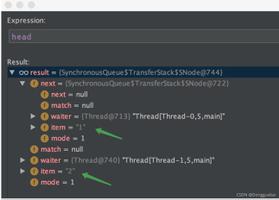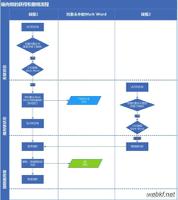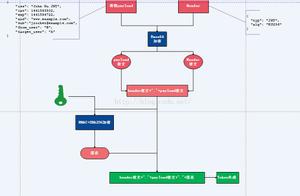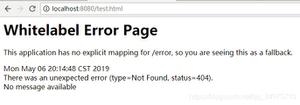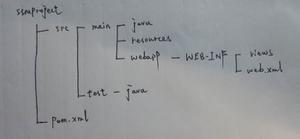java并发:CopyOnWrite机制

java.util.concurrent.CopyOnWriteArrayList是一个线程安全的 ArrayList,其修改操作是在底层的一个复制的数组(快照)上进行的,即用了写时复制策略。
其定义如下:
public class CopyOnWriteArrayList<E>implements List<E>, RandomAccess, Cloneable, java.io.Serializable {
private static final long serialVersionUID = 8673264195747942595L;
/**
* The lock protecting all mutators. (We have a mild preference
* for builtin monitors over ReentrantLock when either will do.)
*/
final transient Object lock = new Object();
/** The array, accessed only via getArray/setArray. */
private transient volatile Object[] array;
/**
* Gets the array. Non-private so as to also be accessible
* from CopyOnWriteArraySet class.
*/
final Object[] getArray() {
return array;
}
其构造函数如下:
/*** Creates an empty list.
*/
public CopyOnWriteArrayList() {
setArray(new Object[0]);
}
/**
* Creates a list containing the elements of the specified
* collection, in the order they are returned by the collection's
* iterator.
*
* @param c the collection of initially held elements
* @throws NullPointerException if the specified collection is null
*/
public CopyOnWriteArrayList(Collection<? extends E> c) {
Object[] es;
if (c.getClass() == CopyOnWriteArrayList.class)
es = ((CopyOnWriteArrayList<?>)c).getArray();
else {
es = c.toArray();
if (c.getClass() != java.util.ArrayList.class)
es = Arrays.copyOf(es, es.length, Object[].class);
}
setArray(es);
}
/**
* Creates a list holding a copy of the given array.
*
* @param toCopyIn the array (a copy of this array is used as the
* internal array)
* @throws NullPointerException if the specified array is null
*/
public CopyOnWriteArrayList(E[] toCopyIn) {
setArray(Arrays.copyOf(toCopyIn, toCopyIn.length, Object[].class));
}
解释:
针对无参构造函数,其内部创建了一个大小为 0 的 Object 数组作为array 的初始值。
其添加元素的方法有多个,如下:
add(E e)的定义如下:
/*** Appends the specified element to the end of this list.
*
* @param e element to be appended to this list
* @return {@code true} (as specified by {@link Collection#add})
*/
public boolean add(E e) {
synchronized (lock) {
Object[] es = getArray();
int len = es.length;
es = Arrays.copyOf(es, len + 1);
es[len] = e;
setArray(es);
return true;
}
}
弱一致性问题
CopyOnWriteArrayList中获取指定位置的元素的方法如下:
/*** {@inheritDoc}
*
* @throws IndexOutOfBoundsException {@inheritDoc}
*/
public E get(int index) {
return elementAt(getArray(), index);
}
static <E> E elementAt(Object[] a, int index) { return (E) a[index];
}
解说:
从上述代码可以知道,当线程 x调用 get方法获取指定位置的元素时需要两步:
- 获取 array数组(步骤A)
- 通过下标访问指定位置的元素 (步骤B)
这个两步操作在整个过程中并没有加锁。
问题:假设线程 x执行完步骤 A 后,在执行步骤 B 前,线程 y进行了 remove操作,这时会发生什么?
remove方法的代码如下:
/*** Removes the element at the specified position in this list.
* Shifts any subsequent elements to the left (subtracts one from their
* indices). Returns the element that was removed from the list.
*
* @throws IndexOutOfBoundsException {@inheritDoc}
*/
public E remove(int index) {
synchronized (lock) {
Object[] es = getArray();
int len = es.length;
E oldValue = elementAt(es, index);
int numMoved = len - index - 1;
Object[] newElements;
if (numMoved == 0)
newElements = Arrays.copyOf(es, len - 1);
else {
newElements = new Object[len - 1];
System.arraycopy(es, 0, newElements, 0, index);
System.arraycopy(es, index + 1, newElements, index,
numMoved);
}
setArray(newElements);
return oldValue;
}
}
remove操作获取独占锁,然后进行写时复制操作,在复制的数组里删除 index 处的元素,随后让 array 指向新复制的数组。
上图指出了线程 x 执行步骤B时操作的数组是线程 y 删除元素之前线程 x 复制的数组。
所以,线程 y 虽然己经删除了 index 处的元素,但是线程 x 的步骤 B 还是会返回index 处的元素,这就是写时复制策略的弱一致性问题。
迭代器弱一致性
大家都知道可以使用法代器遍历List的元素,当调用 CopyOnWriteArrayList 的 iterator()方法获取法代器时,实际上会返回一个 COWiterator对象。
/*** Returns an iterator over the elements in this list in proper sequence.
*
* <p>The returned iterator provides a snapshot of the state of the list
* when the iterator was constructed. No synchronization is needed while
* traversing the iterator. The iterator does <em>NOT</em> support the
* {@code remove} method.
*
* @return an iterator over the elements in this list in proper sequence
*/
public Iterator<E> iterator() {
return new COWIterator<E>(getArray(), 0);
}
static final class COWIterator<E> implements ListIterator<E> { /** Snapshot of the array */
private final Object[] snapshot;
/** Index of element to be returned by subsequent call to next. */
private int cursor;
COWIterator(Object[] es, int initialCursor) {
cursor = initialCursor;
snapshot = es;
}
public boolean hasNext() {
return cursor < snapshot.length;
}
public boolean hasPrevious() {
return cursor > 0;
}
@SuppressWarnings("unchecked")
public E next() {
if (! hasNext())
throw new NoSuchElementException();
return (E) snapshot[cursor++];
}
@SuppressWarnings("unchecked")
public E previous() {
if (! hasPrevious())
throw new NoSuchElementException();
return (E) snapshot[--cursor];
}
public int nextIndex() {
return cursor;
}
public int previousIndex() {
return cursor - 1;
}
/**
* Not supported. Always throws UnsupportedOperationException.
* @throws UnsupportedOperationException always; {@code remove}
* is not supported by this iterator.
*/
public void remove() {
throw new UnsupportedOperationException();
}
/**
* Not supported. Always throws UnsupportedOperationException.
* @throws UnsupportedOperationException always; {@code set}
* is not supported by this iterator.
*/
public void set(E e) {
throw new UnsupportedOperationException();
}
/**
* Not supported. Always throws UnsupportedOperationException.
* @throws UnsupportedOperationException always; {@code add}
* is not supported by this iterator.
*/
public void add(E e) {
throw new UnsupportedOperationException();
}
@Override
public void forEachRemaining(Consumer<? super E> action) {
Objects.requireNonNull(action);
final int size = snapshot.length;
int i = cursor;
cursor = size;
for (; i < size; i++)
action.accept(elementAt(snapshot, i));
}
}
解说:
COWiterator对象的 snapshot变量保存了当前 array的内容,cursor是遍历数据的下标。
在线程使用返回的迭代器遍历元素的过程中,如果有其他线程对 list 进行了增删改,那么 snapshot就是快照了。
因为增删改后指向 array的变量(即本文最开始着色了的那行代码,private transient volatile Object[] array;)指向了新数组。
所以在获取迭代器遍历元素时,其他线程对 list 进行的增删改对外不可见,因为它们操作的是两个不同的数组,这就是弱一致性。
CopyOnWriteArraySet
java.util.concurrent.CopyOnWriteArraySet是在CopyOnWriteArrayList的基础上使用了装饰模式,其很多方法都是调用CopyOnWriteArrayList的API来实现的。
其添加元素的代码如下:
/*** Adds the specified element to this set if it is not already present.
* More formally, adds the specified element {@code e} to this set if
* the set contains no element {@code e2} such that
* {@code Objects.equals(e, e2)}.
* If this set already contains the element, the call leaves the set
* unchanged and returns {@code false}.
*
* @param e element to be added to this set
* @return {@code true} if this set did not already contain the specified
* element
*/
public boolean add(E e) {
return al.addIfAbsent(e);
}
解说:
从CopyOnWriteArraySet的定义以及构造函数可以看到其底层数据结构就是CopyOnWriteArrayList,代码如下:
public class CopyOnWriteArraySet<E> extends AbstractSet<E>implements java.io.Serializable {
private static final long serialVersionUID = 5457747651344034263L;
private final CopyOnWriteArrayList<E> al;
/**
* Creates an empty set.
*/
public CopyOnWriteArraySet() {
al = new CopyOnWriteArrayList<E>();
}
/**
* Creates a set containing all of the elements of the specified
* collection.
*
* @param c the collection of elements to initially contain
* @throws NullPointerException if the specified collection is null
*/
public CopyOnWriteArraySet(Collection<? extends E> c) {
if (c.getClass() == CopyOnWriteArraySet.class) {
@SuppressWarnings("unchecked") CopyOnWriteArraySet<E> cc =
(CopyOnWriteArraySet<E>)c;
al = new CopyOnWriteArrayList<E>(cc.al);
}
else {
al = new CopyOnWriteArrayList<E>();
al.addAllAbsent(c);
}
}
以上是 java并发:CopyOnWrite机制 的全部内容, 来源链接: utcz.com/z/394690.html


